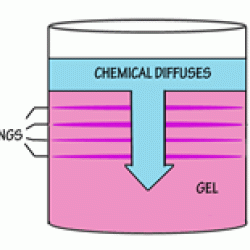Source Institutions
Source Institutions
Add to list Go to activity
Activity link broken? See if it's at the internet archive

This display shows slow chemical reactions in colorful crystal formations known as Liesegang Rings. These reactions are similar to those forming the rings in agates. This activity is recommended for upper-level chemistry learners and requires observations over a period of days weeks and months. It's been documented that these reactions will last for up to 30 years. The operating guide details the chemical composition of the five different chemicals and gels, and provides documentation for articles to research for more recipes and background information.
- 4 to 24 hours
- 1 to 4 weeks
- $5 - $10 per student
- Ages 14 - adult
- Activity, Demonstration, Exhibit, Experiment/Lab Activity
- English
Quick Guide
Materials List (per student)
- 250mL sodium silicate solution 40% w/v (water glass)
- 600mL vinegar (household, 5% acetic acid)
- stirring plate
- magnetic stir bar
- 2L beaker
- 1L beaker
- 250mL graduated cylinder
- 1L graduated cylinder
- 1.5L storage bottle
- 1L storage bottle
- plexiglas barrier
- cross-section samples of agate with rings
- 5 250mL graduated cylinders or other suitable containers
- other chemicals and equipment are listed in Materials Prep in the specific recipe
Subjects
-
Earth and Space Science
-
Earth Structure
- Rocks and Minerals
-
Earth's History
- Geologic Time
-
Earth Structure
-
Mathematics
-
Measurement
- Rate
-
Measurement
-
Physical Sciences
-
Chemistry
- Chemical Reactions
- Oxidation-Reduction Reactions
-
Chemistry
Informal Categories
- Nature and Environment
Audience
To use this activity, learners need to:
- see
- see color
Learning styles supported:
- Involves hands-on or lab activities
Other
Components that are part of this resource:
This resource is part of:
Access Rights:
- Free access
By:
Rights:
- All rights reserved, Oregon Museum of Science and Industry, 1997
Funding Source:
- National Science Foundation
